目录
效果预览
用扣子平台通过工作流的方式搭建了微博关键词爬虫,通过对话方式,效果如下:
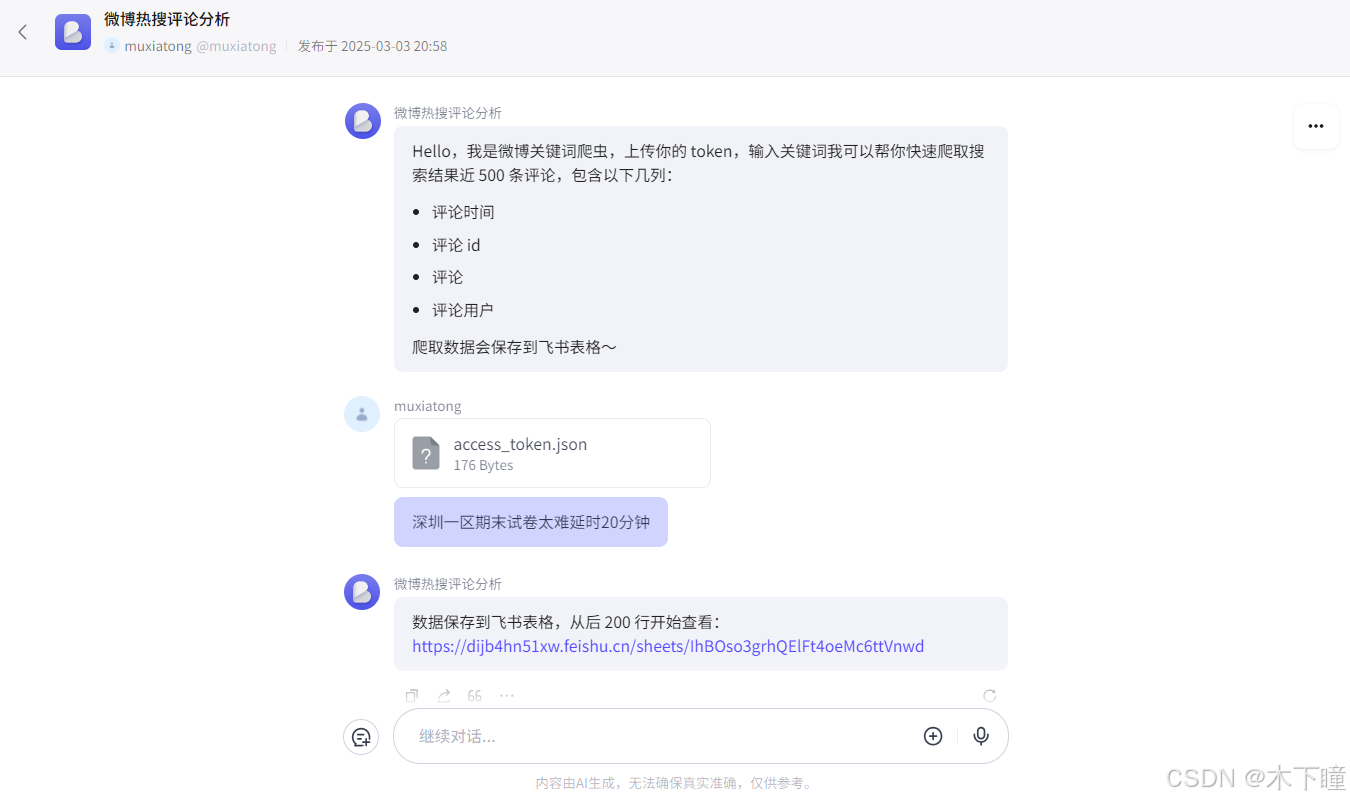
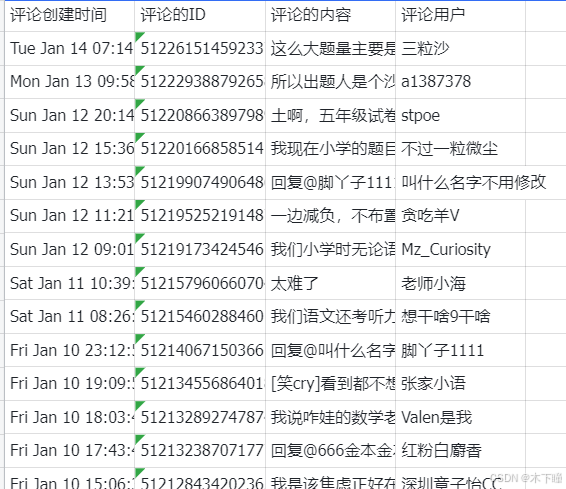
调用的是微博官方的 api 接口,有一定限制,不适合大量爬取,适合场景为想要快速根据词条获得一些评论数据进行分析的人使用。
所以可以通过工作流方式进行封装,主要是把爬虫代码封装进工作流。
微博api
爬虫用到的 api,因为需要登录才能获得数据,且扣子不支持把以下代码封装,所以我们我们需要用自己微博账号注册一个应用获得 app key,app secret,参考链接:
获得后使用 python 运行以下代码,
client_key = '你的 app key',
client_secret = '你的 app secret'
记得替换为你自己的,其他不用任何修改
python
import json
import requests
import webbrowser
import time
def get_access_token():
# 授权步骤
# https://open.weibo.com/wiki/%E6%8E%88%E6%9D%83%E6%9C%BA%E5%88%B6%E8%AF%B4%E6%98%8E#.E5.BA.94.E7.94.A8.E5.9C.BA.E6.99.AF
# 第一步 authorize 接口,请求用户授权code
# https://open.weibo.com/wiki/Oauth2/authorize
client_key = '你的 app key'
redirect_uri = 'https://api.weibo.com/oauth2/default.html'
url1 = 'https://api.weibo.com/oauth2/authorize'
res_1 = requests.get(url1, params={'client_id': client_key, 'redirect_uri': redirect_uri})
webbrowser.open_new(res_1.url)
code = input('输入 code:')
# 第二步 access_token 接口,用 code 换取授权 access_token
# https://open.weibo.com/wiki/Oauth2/access_token
client_secret = '你的 app secret'
url2 = 'https://api.weibo.com/oauth2/access_token'
res_2 = requests.post(url2, data={
'client_id': client_key, 'client_secret': client_secret, 'redirect_uri': redirect_uri,
'grant_type': 'authorization_code', 'code': code})
data = res_2.json()
access_token = data['access_token']
expires_in = data['expires_in']
print(f'token:{access_token}, 有效时间:{expires_in}s')
# 获取当前时间戳(以秒为单位)
current_timestamp = int(time.time())
# 计算过期时间戳
expiration_timestamp = current_timestamp + expires_in
# 保存
data['expiration_timestamp'] = expiration_timestamp
with open('access_token.json', 'w') as f:
f.write(json.dumps(data, ensure_ascii=False))
return access_token
print(get_access_token())运行后会在打开浏览器,你需要用微博扫码登录后会变成以下页面,输入这个 code 会得到结果 json 文件:
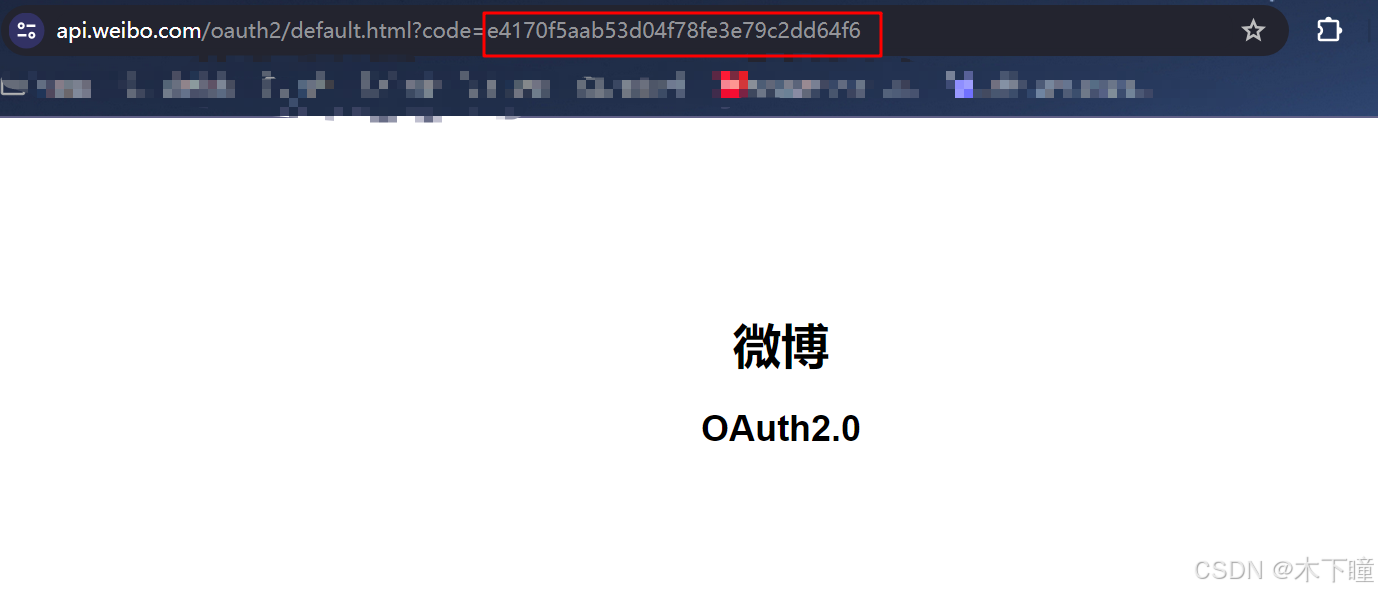
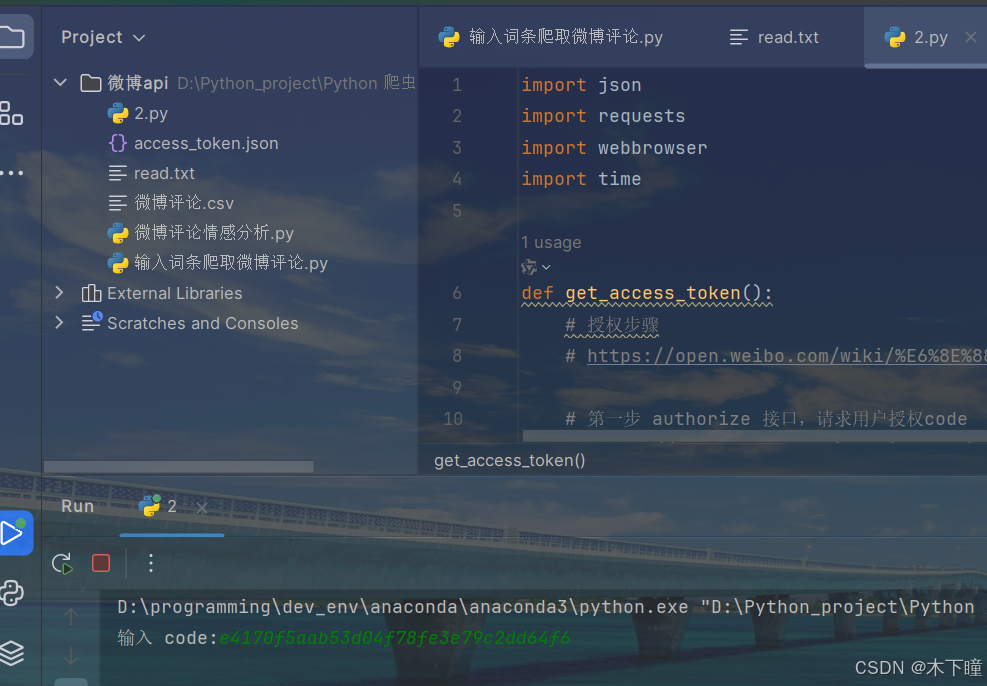
代码同目录获得 access_token.json 文件:

这是我们需要上传到工作流的凭证。
工作流搭建

打开扣子,新建项目,选择对话流模式,设置开场白:
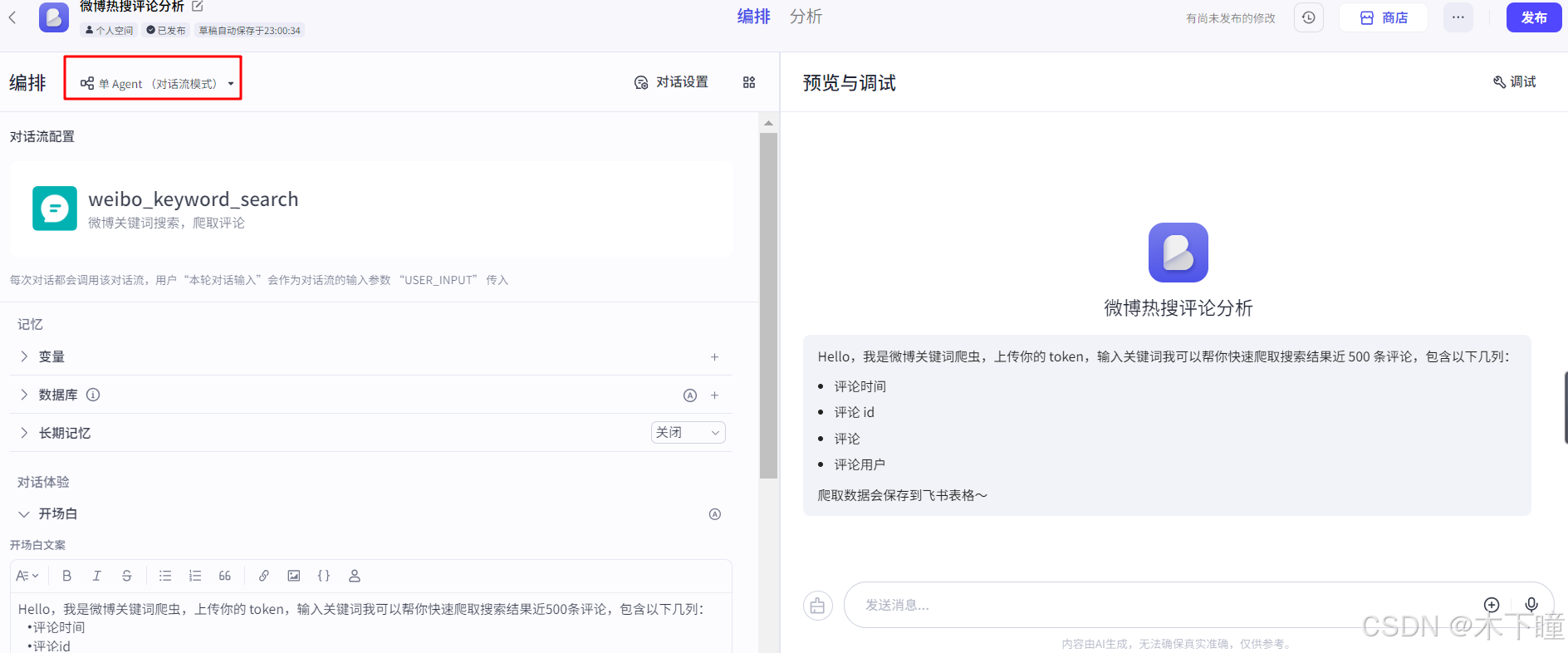
添加对话流,即新建对话流,开始节点不用动,添加一个代码节点,用来分割用户输入的关键词及 token 文件链接,输入引用用户的输入,输出添加 ret 变量中的字段:
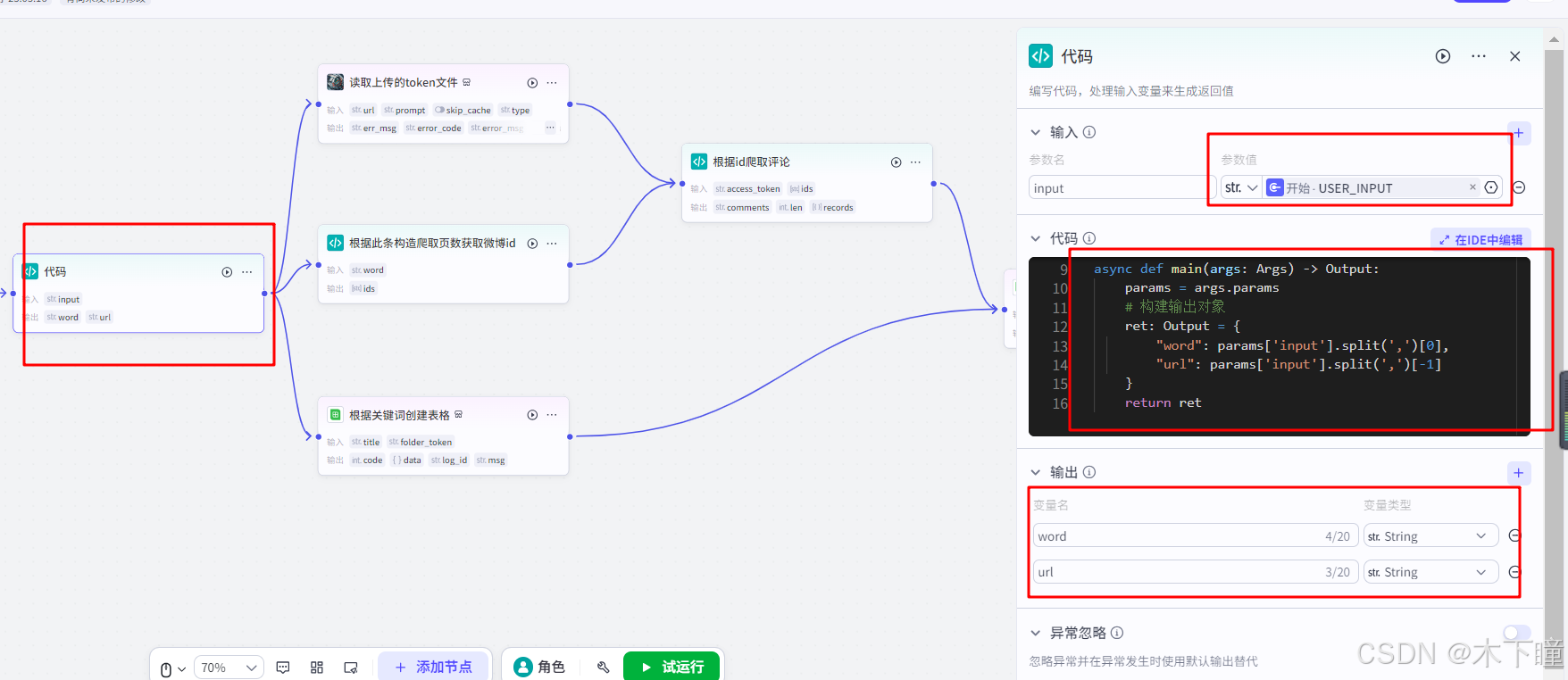
python
async def main(args: Args) -> Output:
params = args.params
# 构建输出对象
ret: Output = {
"word": params['input'].split(',')[0],
"url": params['input'].split(',')[-1]
}
return ret添加插件节点"读取上传的token文件",输入引用代码分割后的 url,此 url 是用户上传后 token 的 url,也就是读取文件内容的插件,这里读 token
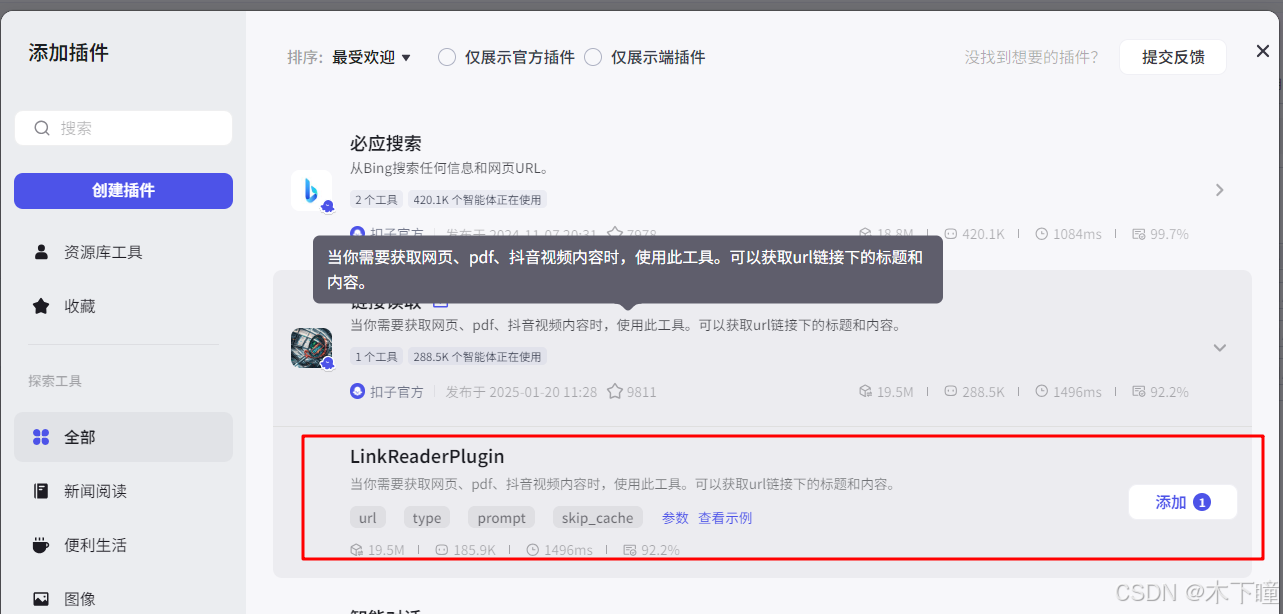
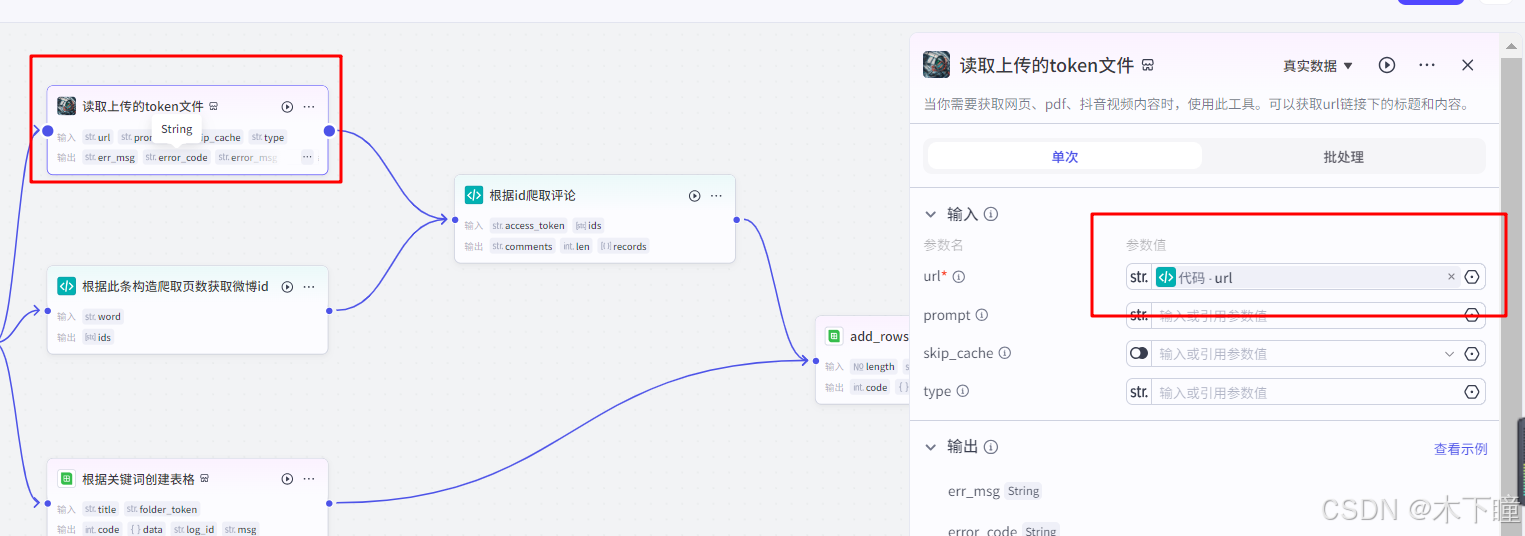
根据此条构造爬取页数获取微博id,也是一个代码节点,爬虫代码的一部分,输入引用代码分割后得到的词条,输出爬取得到微博 ids:
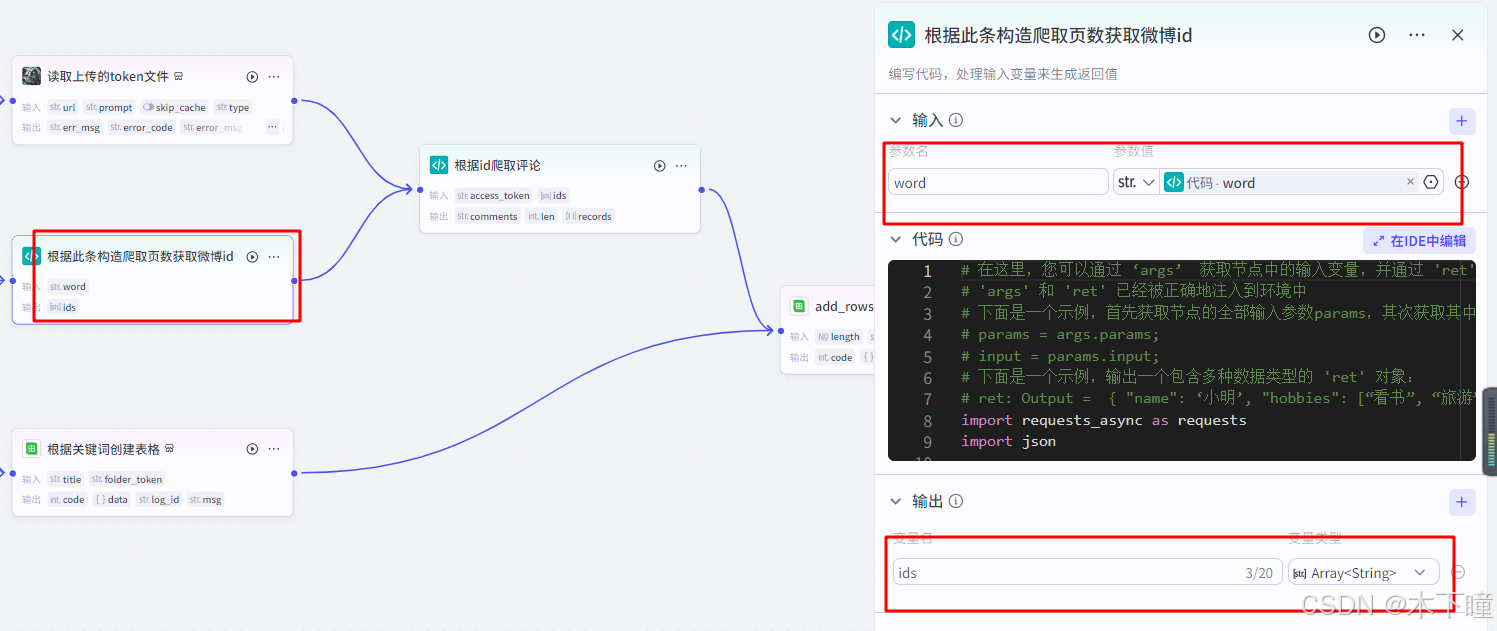
python
import requests_async as requests
import json
async def main(args: Args) -> Output:
params = args.params
word = params['word']
urls = ['https://m.weibo.cn/api/container/getIndex?containerid=100103type%3D1%26q%3D{}&page_type=searchall&page={}'
.format(word, i) for i in range(1, 51)]
headers = {
'User-Agent': 'Mozilla/5.0 (Windows NT 10.0; Win64; x64) AppleWebKit/537.36 (KHTML, like Gecko) Chrome/80.0.3987.163 Safari/537.36',
}
async def get_ids(urls):
# 获取多页 id
ids = []
for index, url in enumerate(urls):
print(f'当前页数 {index + 1}/{len(urls)}........')
response = await requests.get(url, headers=headers)
data = json.loads(response.text)
cards = data['data']['cards']
for d in cards:
try:
id_ = d['mblog']['id']
except KeyError:
try:
id_ = d['card_group'][0]['mblog']['id']
except KeyError:
id_ = ''
if id_ != '':
ids.append(id_)
print(f'总共 {len(ids)} 条微博.')
return ids
ids = await get_ids(urls)
# 构建输出对象
ret: Output = {
"ids": ids[:1]
}
return ret数据用飞书电子表格保存,所以添加两个插件节点,一个是创建表格,一个是写入表格;
创建表格的名称引用代码分割的词条:
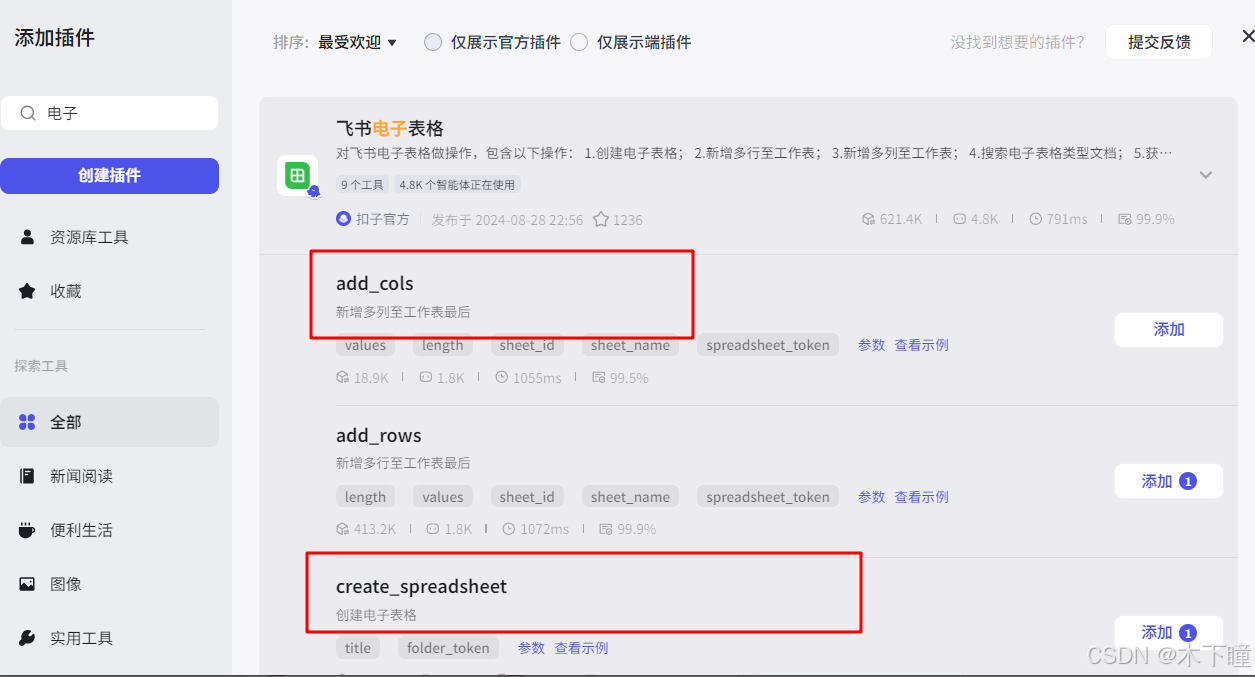
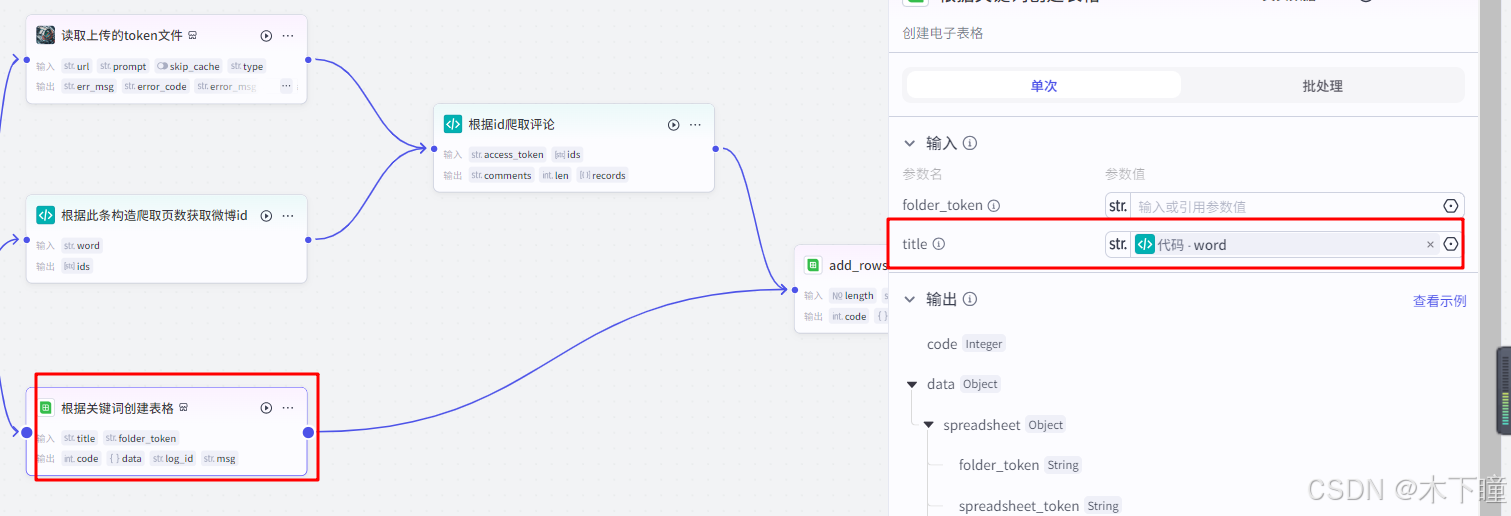
根据微博id爬取评论,也是一个代码节点,输入引用读取获得的 token,以及爬取得到的微博ids,输出爬取得到的评论列表及长度:
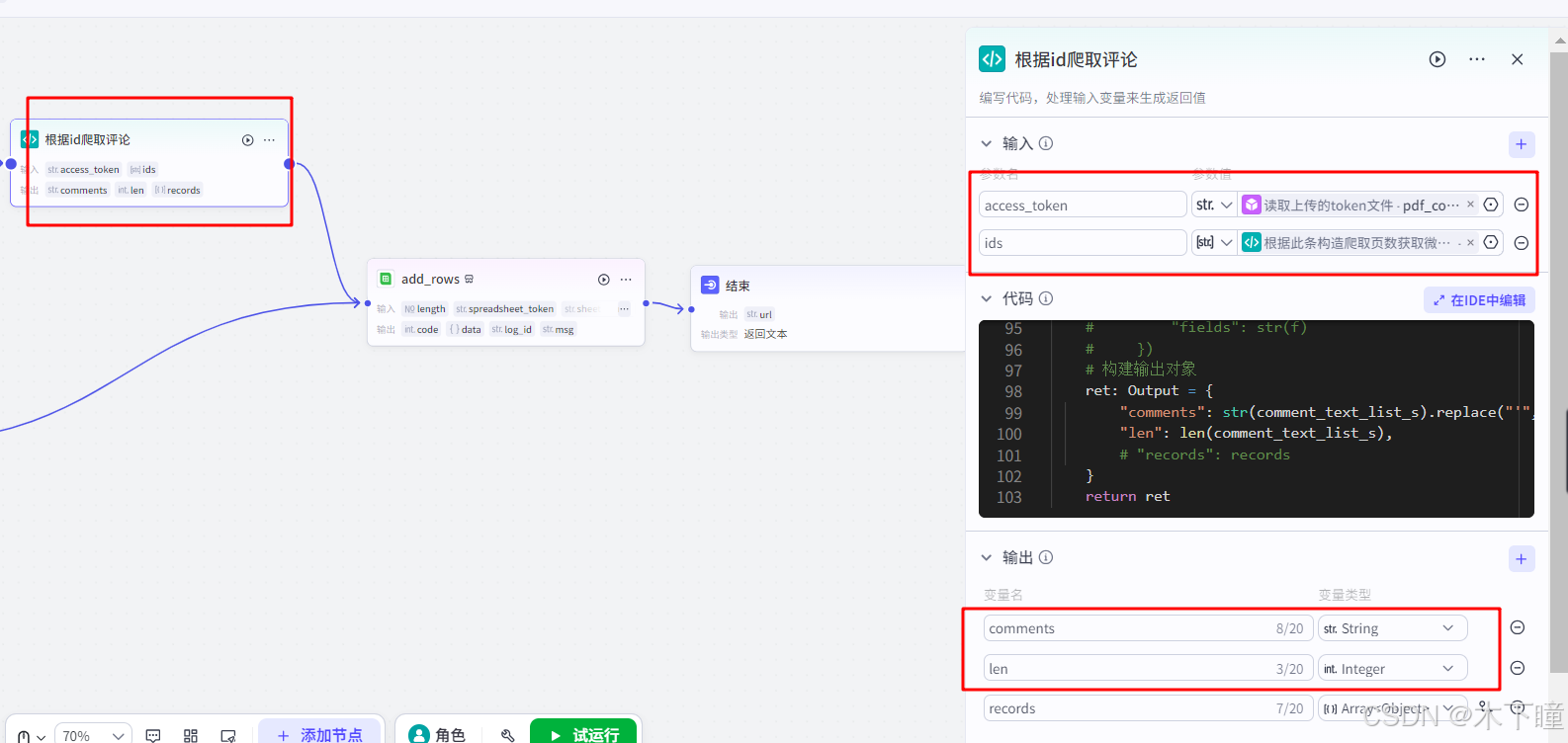
python
import json
import requests_async as requests
async def main(args: Args) -> Output:
params = args.params
ids = params['ids']
access_token = json.loads(params['access_token'])['access_token']
comment_text_list_s = [['评论创建时间', '评论的ID', '评论的内容', '评论用户']]
for index, _id in enumerate(ids):
created_at_lst = [] # 保存所有评论创建时间
id_lst = [] # 保存所有评论的 id
text_lst = [] # 保存所有评论的 text
user_lst = [] # 保存所有评论的 user 信息
user_name_lst = [] # 保存所有评论的 user 名称
mid_lst = [] # 保存所有评论的 mid
idstr_lst = [] # 保存所有评论的字符串 id
status_lst = [] # 保存所有评论的微博信息
reply_comment_lst = [] # 保存所有评论来源评论,当本评论属于对另一评论的回复时返回此字段
# 共获取 2 页 * 每页最多 100 条评论
flag = 0
for i in range(1, 3):
url = 'https://api.weibo.com/2/comments/show.json'
result = await requests.get(url, params={'access_token': access_token, 'id': _id, 'count': 100})
# 判断是否被限流
if json.loads(result.text).get('error') is not None:
print(f'可能被限流了,{result.text}')
exit(0)
comments = json.loads(result.text)['comments']
if not len(comments):
break
for item in comments:
created_at = item['created_at']
comment_id = item['id']
text = item['text']
user = item['user']
user_name = user['name']
mid = item['mid']
idstr = item['idstr']
status = item['status']
reply_comment = item.get('reply_comment')
# 判断时候评论开始重复
if idstr in idstr_lst:
print(f'当前页数 {i} 评论重复,跳过')
flag = 1
break
created_at_lst.append(str(created_at))
id_lst.append(str(comment_id))
text_lst.append(str(text))
user_lst.append(str(user))
user_name_lst.append(str(user_name))
mid_lst.append(str(mid))
idstr_lst.append(str(idstr))
status_lst.append(str(status))
reply_comment_lst.append(str(reply_comment))
if flag:
break
# comment_text_list = list(zip(created_at_lst, id_lst, text_lst, user_lst, user_name_lst, mid_lst,
# idstr_lst, status_lst, reply_comment_lst))
comment_text_list = list(zip(created_at_lst, id_lst, text_lst, user_name_lst))
comment_text_list_s.extend(comment_text_list)
comment_text_list_s = comment_text_list_s
comment_text_list_s = [list(i) for i in comment_text_list_s]
# records = []
# for c in comment_text_list_s:
# f = {
# "评论创建时间": c[0],
# "评论的ID": c[1],
# "评论的内容": c[2],
# "评论的点赞数": c[3],
# "评论用户": c[4],
# "评论用户ID": c[5],
# "字符串型的评论ID": c[6],
# "评论的微博信息": c[7],
# "评论来源评论": c[8]
# }
# records.append({
# "fields": str(f)
# })
# 构建输出对象
ret: Output = {
"comments": str(comment_text_list_s).replace("'", '"'),
"len": len(comment_text_list_s),
# "records": records
}
return ret写入数据到表格,输入引用如下图:
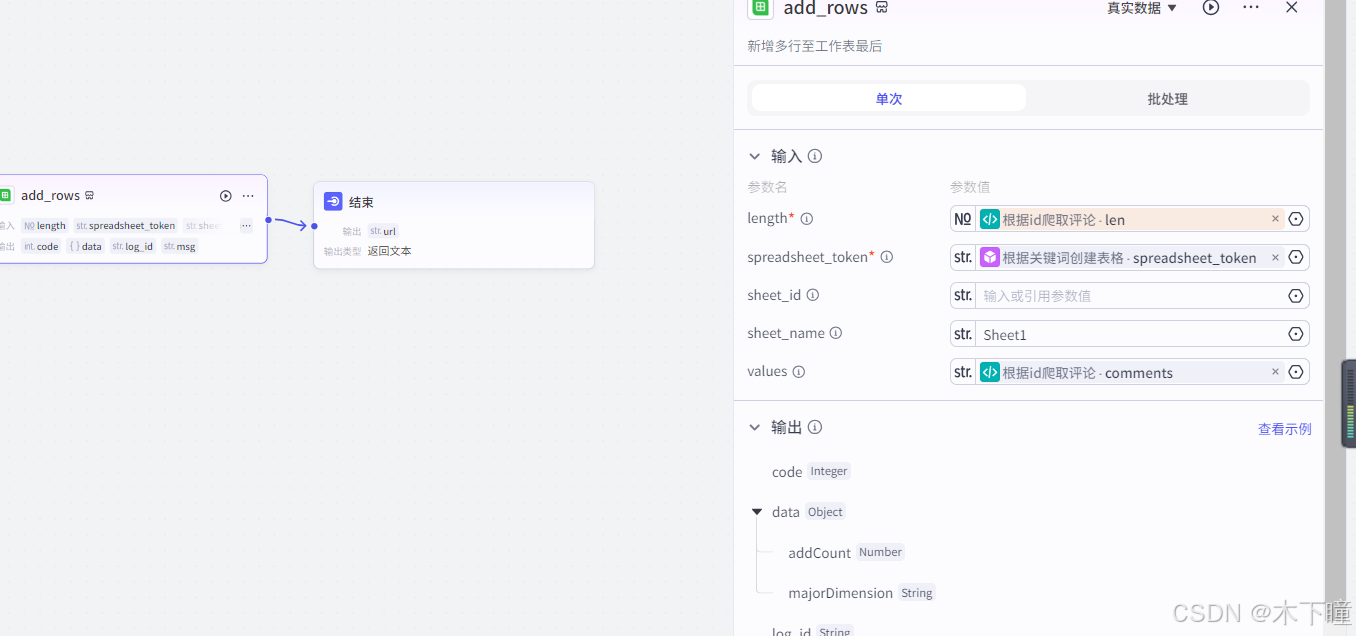
结束节点,就输出回复,飞书表格链接,要从后 200 行开始看:
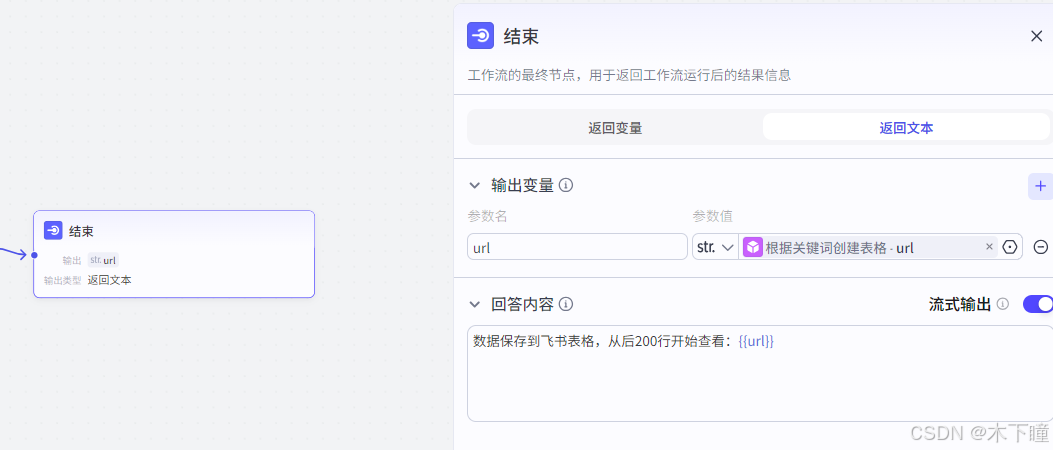
对话流配置好发布,在刚开始项目中添加即可完成了
